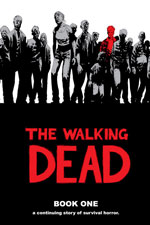 written by Robert Kirkman
written by Robert KirkmanArt by Tony Moore, Charlie Adlard, and Cliff Rathburn
reviewed by Jason Wheatley
If you’ve been anywhere near a comic store in the last couple of years, then you’ve probably heard at least a passing mention of Robert Kirkman’s smash-hit zombie book, Marvel Zombies. Years before that, though, Kirkman arguably started the resurgence of zombie comics with The Walking Dead from Image. For as much as Marvel Zombies mines the genre for dark comedy, The Walking Dead treats it as fertile ground for a serious, introspective look at human nature and the lengths to which people will go in order to protect themselves and their loved ones.
TWD follows a group led by former Georgia sheriff Rick Sheridan, survivors of a zombie apocalypse of unknown origin. While it would be easy to fall into the trap of showing zombie attack after zombie attack and fill the pages with gore, Kirkman wisely realizes that’s a gimmick, not a way to build a long-running series. The focus is on the survivors and how they find their place in a new world where the old rules no longer apply. The title itself, Kirkman says, refers not to the zombies but to the survivors. In fact, there are entire issues where no zombies appear at all. Naturally, a zombie comic book wouldn’t be very successful without, well, zombies, but their sparse appearances enhance the suspense and drama, also making the violence much more shocking when it finally comes.
While the undead remain an ever-present threat, in many instances, the greater danger comes from those who remain among the living. This has never been more true than in the current storyline, which finds “our” group of survivors facing off against the brutal, amoral Governor and his followers for control of the prison our group has called home for the bulk of the series. In the years since the title began, main characters have been maimed, tortured, and killed – literally, no one is safe. That’s a claim many titles make, but TWD is one of the few titles that regularly lives up to it. As the title moves toward its 50th issue, Kirkman’s claim that “nothing will ever be the same again” has already rung true, and the storyline has yet to reach its conclusion. Particularly during this latest story, Kirkman has excelled at presenting the fear and despair of a cast who know their end could come at any moment, as well as the remorseless depravity of a man who operates at humanity’s basest level in the Governor.
As powerful as Kirkman’s writing is, it would fall flat without the right art. After an opening story arc by Tony Moore, Charlie Adlard and inker Cliff Rathburn have been the art team, consistently delivering visceral, emotional characters and capturing the horrors of the violent world they live in. The book is in black and white, which adds to the starkness of the images, and the heavy use of blacks reflects the darkness of many characters and the despair of others. Many letter writers in the book’s letters column wonder if Kirkman would ever consider changing the book to color; Kirkman wisely maintains that he won’t. Changing to color would only diminish the power of Adlard and Rathburn’s images.
The Walking Dead is, at its heart, a zombie comic book. But more than that, it’s a reflection on the extremes to which a catastrophe can push humanity. An excellent book for fans of the zombie genre, it’s also an incredible exploration of human nature that I give my highest recommendation. Much like the George Romero zombie movies that are a clear inspiration for the series, TWD explores social and personal themes that run much deeper than the violent horror on its surface would indicate. Although he works in a different medium, Kirkman has cemented himself as a worthy successor to Romero’s legacy.
The Walking Dead is published monthly by Image Comics; seven trade paperbacks and three hardcover volumes also are available.


1 comment:
Walking Dead #1 is the first comic I ever bought at Heroes Aren't Hard To Find.
Post a Comment